Whitehorse to Dawson City, Yukon
An early morning caravan from Whitehorse had us departing the Alaska Highway and heading north on the Klondike Highway 2 to Dawson City.
We did encounter construction and rebuilding of a bridge just after heading north on highway 2, the Klondike Highway.
We saw many signs warning motorists of the presence of wildlife on the road, but did not actually see any first hand.
Our morning rest stop was at Braeburn Lodge, famous for it's enormous, fresh baked cinnamon buns. Naturally we all had to have one.
One of our fellow travelers left his bun on the galley table, and upon his return to his motorhome, he found that his poodle, Lance had eaten the entire thing.
I'm glad I wasn't spending the night in that rig!
Dawson City
We had a very busy few days here in Dawson City. Our first night at Bonanza Creek RV Park was a quiet one, following a busy travel day.
A warm welcome to Dawson City. We were greeted with a welcome song from one of the First Nations Tribe.
An outstanding historic City walking tour, conducted by Anna, our superb, Parks Canada guide.
The bank where the prospectors weighed and deposited their gold.
The scale at the bank that weighed the prospector's gold.
The local saloon and meeting place.
The old Post Office
The historic Post Office.
After a hearty lunch, Spike, our tour guide conducted a driving tour of the area, starting with the second, of only two RCMP cemeteries.
It was interesting to note the ages of these young constables in a time before antibiotics were available.
After the very interesting tour of all the city cemeteries, Spike took us up the hill to "Midnight Dome".
Here, you see the confluence of the Yukon and Klondike Rivers. One can clearly see the difference between the two.
The Yukon River is a murky, cloudy color, due to glacial melt and all of the glacial silt (aka rock flour).
The Klondike river, not being glacial melt, is clear.
It is interesting to note that the rivers flow separately for several miles before mixing and becoming one.
The Yukon River is a murky, cloudy color, due to glacial melt and all of the glacial silt (aka rock flour).
The Klondike river, not being glacial melt, is clear.
It is interesting to note that the rivers flow separately for several miles before mixing and becoming one.
On top of Midnight Dome, overlooking Dawson City and the Yukon and Klondike rivers.
This busy day ended with Spike's gold panning instruction. We all headed out to Claim 6, a free claim, where we were shown the art of panning for gold.

We learned the art of washing and sluicing the dirt around, and out of the pan.
If you were lucky, there would be a few flakes of gold left in your pan.
At the start, we were all very intense, with most of us not mastering Spike's technique.
It truly was back breaking work, and not something I would quit my day job for. Finding a few flecks of gold was fun and exciting, but boy, did I pay for it next few days.......I could barely move!
This was the collective total of Alan's and my hard labors.
Spike's Tour of Klondike Dredge #4
These massive dredges would travel in a pool of self dug water, scooping up the gold bearing gravel, processing the gravel through a gold saving sluice, and depositing the tailings (gravel) in long piles along the way.
The dredge, a Parks Canada Historic site was undergoing some renovations and hence, we were unable to tour aboard.
The landscape has been ravaged over the years with miles and miles of tailing deposits just left.
Dredges are no longer used in gold excavation. Heavy earth moving equipment such as bulldozers and front end loaders are now the method of choice. This modern miner, still working Bonanza Creek, as all miners nowadays, was required to post a bond and return the land to it's pre-mining state.
Just a mile or so up the road is the "Discovery Claim", the site where on 17 August 1896, Skookum Jim, Tagish Charlie and George Carmack struck gold on Bonanza Creek, and staked the first claim, setting off the start of the Klondike Gold Rush.
This is the site of the Discovery Claim, where gold was first discovered on Bonanza Creek.




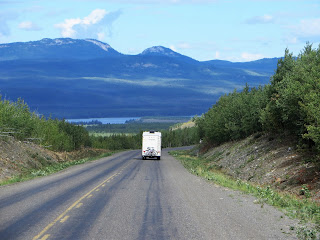










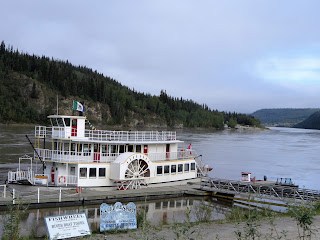





















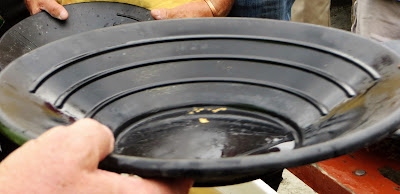




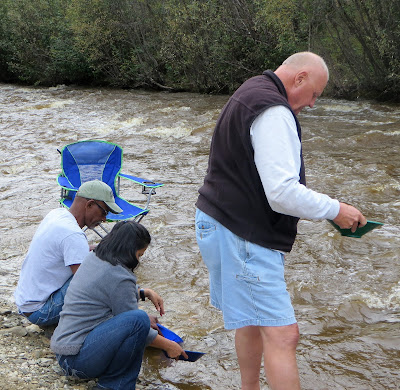




























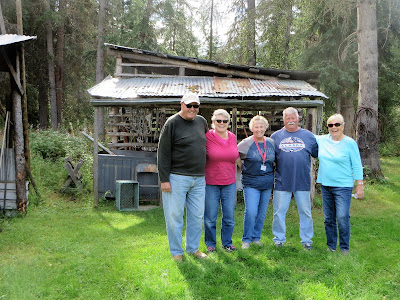








No comments:
Post a Comment